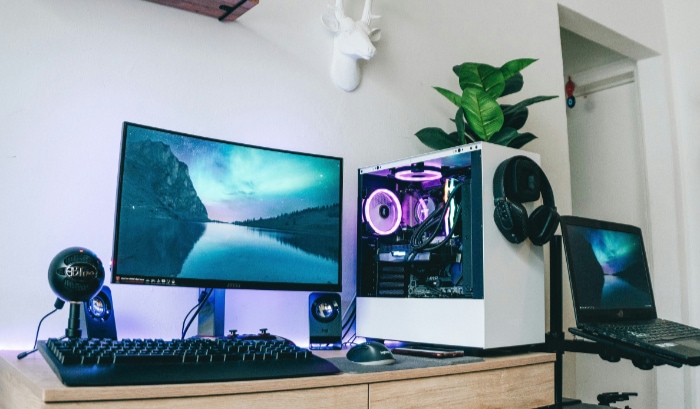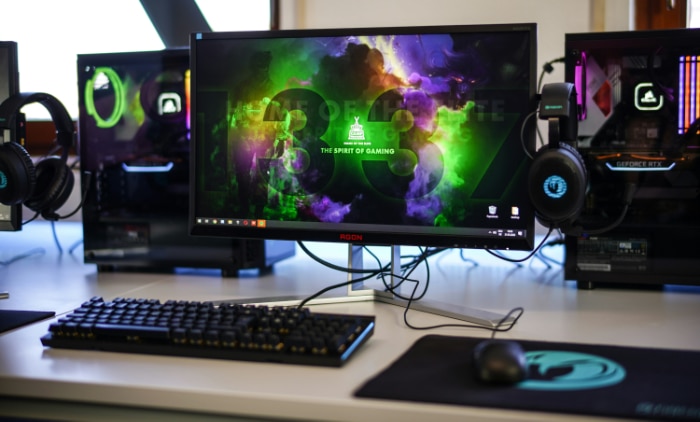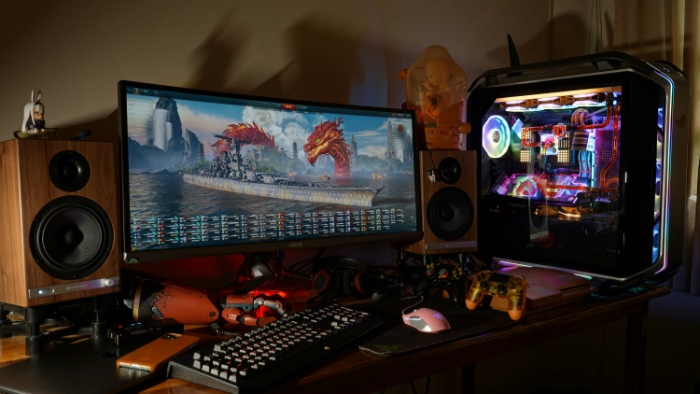Freesync On or Off: Smoothing Your Gameplay

Exploring the world of gaming technology often leads us to the crossroads of decision-making, especially when it comes to optimizing our visual experience. One such choice gamers frequently encounter is whether to turn Freesync on or off.
This technology, designed to enhance your gaming session by smoothing out visuals and reducing screen tearing, sits at the heart of many debates among gaming enthusiasts. With the promise of a seamless gaming experience on one hand and a plethora of considerations on the other, deciding on Freesync’s role in your setup is more than just flipping a switch.
Understanding Freesync
Freesync technology has emerged as a game-changer in the realm of gaming, offering solutions to some of the most common yet frustrating issues gamers face: screen tearing and stuttering. By synchronizing the refresh rate of your display with the frame rate of your graphics card, Freesync ensures a smoother visual experience.
What is Freesync?
Developed by AMD, Freesync is an adaptive synchronization technology. It’s designed to support a dynamic refresh rate, meaning the monitor can adjust its refresh rate to match the frame rate output by the graphics card in real-time.
This functionality is crucial in preventing screen tearing, a visual artifact that occurs when the display shows pieces of multiple frames at once. Freesync operates within a specific range of refresh rates, typically between 40 Hz and 144 Hz, although this can vary based on the monitor.
How Freesync Enhances Your Gaming Experience
The primary benefit of Freesync lies in its ability to deliver a fluid, tear-free gaming experience. By eliminating screen tearing and minimizing stuttering and input lag, gamers can enjoy their favorite titles the way they were meant to be seen.
This is especially beneficial in fast-paced games where split-second reactions are crucial. With Freesync, the action on your screen becomes as seamless as possible, ensuring that every movement is smooth and every detail is crisp.
Freesync vs. V-Sync
It’s important to differentiate Freesync from V-Sync, another technology aimed at combating screen tearing. V-Sync, or vertical sync, works by limiting the frame rate of the game to match the monitor’s fixed refresh rate.
While this can reduce tearing, it often introduces input lag and can cause stuttering if the game’s frame rate drops below the refresh rate of the monitor. Freesync, on the other hand, dynamically adjusts the monitor’s refresh rate to the game’s frame rate, offering a more fluid experience without the drawbacks associated with V-Sync.
When to Turn Freesync On
Deciding when to activate Freesync involves understanding the conditions under which this technology can enhance your gaming or visual content experience. Freesync’s primary goal is to smooth out visuals and eliminate issues that detract from a seamless viewing experience.
Optimal Conditions for Freesync
Freesync shines in scenarios where the frame rate of your games fluctuates. For gamers, these fluctuations can disrupt the immersion and responsiveness of gameplay.
By matching the display’s refresh rate with the game’s frame rate, Freesync ensures a fluid motion without tearing, making it ideal for dynamic, fast-paced games where action is continuous and the scene changes rapidly.
Benefits for Various Types of Games
While Freesync is beneficial across a broad spectrum of games, it particularly enhances the experience in genres that demand high frame rates for optimal play. First-person shooters (FPS), racing games, and any titles with quick movements and rapidly changing visuals stand to gain the most.
In these games, the difference between victory and defeat can often be measured in milliseconds, and the smoother motion provided by Freesync can be a game-changer.
Considering Your Hardware Setup
Your decision to turn Freesync on should also take into account the capabilities of your hardware. If you have a gaming setup that frequently pushes the boundaries of your monitor’s maximum refresh rate, enabling Freesync can prevent screen tearing when the frame rate dips.
Conversely, if your system struggles to meet the minimum frame rate supported by your Freesync monitor, you might not experience the full benefits of the technology.
Impact on Visual Quality
For those who prioritize visual fidelity over outright performance, Freesync ensures that the quality of the visuals remains consistent, without the distracting effects of tearing or stuttering. It’s particularly useful when playing graphically intensive games that can cause significant variations in frame rate, as it helps maintain a balance between performance and visual quality.
Adaptive Sync for Professional and Casual Use
Beyond gaming, Freesync also offers advantages for professional applications that involve video editing or animation work, where screen tearing can disrupt the editing process. Casual users watching high-frame-rate videos or engaging in any form of multimedia consumption will notice a smoother, more pleasant viewing experience with Freesync enabled.
Considerations for Turning Freesync Off

While Freesync offers significant advantages in enhancing the gaming and viewing experience, there are specific scenarios where turning it off might be beneficial.
Compatibility with Non-Gaming Applications
For tasks that don’t involve gaming or video playback, such as general web browsing or document editing, the advantages of Freesync are less pronounced. In these scenarios, keeping Freesync enabled may not offer any noticeable benefits, and turning it off could potentially reduce power consumption on your display and graphics card.
High-Performance Gaming Situations
In high-stakes gaming scenarios where every millisecond counts, such as competitive esports, the slightest delay can affect performance. While Freesync reduces screen tearing and stutter, some gamers might prefer to turn it off to minimize input lag to the lowest possible.
This is particularly the case in games where the frame rate consistently exceeds the upper limit of the Freesync range, as the technology then ceases to function, making its use redundant.
Issues with Specific Games or Applications
Certain games or applications may exhibit compatibility issues with Freesync, leading to unexpected behavior such as flickering, black screens, or other glitches. If you encounter such problems, disabling Freesync can be a troubleshooting step to determine if it is the source of the issue.
It’s also worth checking for updates from the game developers or your graphics card manufacturer, as these issues can sometimes be resolved through software updates.
Maximizing Battery Life on Laptops
For laptop users, power efficiency is a key consideration, especially when operating on battery power. Freesync can increase power consumption, as it requires the GPU to work harder to dynamically adjust the display’s refresh rate.
Turning Freesync off when battery life is a priority can help extend the duration of your laptop’s use on a single charge, particularly when engaging in less demanding tasks.
Personal Preference and Visual Sensitivity
Some users may not notice the visual improvements offered by Freesync, or they might prefer the visual characteristics of their display without adaptive sync technologies. Personal sensitivity to screen tearing and input lag varies, and some might prioritize the raw performance or visual output of their hardware without the influence of Freesync.
In these cases, experimenting with Freesync on and off can help users determine their preferred settings based on their specific sensitivities and priorities.
Hardware Compatibility and Requirements
Freesync technology, while versatile, requires specific hardware support to function correctly. This means not every setup will automatically benefit from Freesync’s adaptive synchronization capabilities.
Graphics Cards Compatibility
Freesync was developed by AMD and is naturally supported across a wide range of AMD graphics cards. This includes many models from the Radeon series, starting from the Radeon HD 7000 series onwards.
In recent developments, NVIDIA has also extended support for Freesync through its “G-Sync Compatible” initiative, allowing users with certain NVIDIA graphics cards to take advantage of Freesync monitors. However, it’s essential to check the specific model of your graphics card and its driver support to confirm Freesync compatibility.
Freesync Monitors
A monitor that supports Freesync is required to utilize this technology. Freesync monitors vary widely in terms of refresh rate range, resolution, and panel type, catering to different gaming needs and budgets.
The monitor’s Freesync range is particularly important, as it dictates the frame rates over which Freesync can effectively eliminate screen tearing. It’s also worth noting that some monitors may offer a broader Freesync range or support for Freesync Premium or Freesync Premium Pro, offering higher standards in terms of performance, such as support for low framerate compensation (LFC).
Connection Standards
The type of connection between your graphics card and monitor can affect Freesync compatibility. DisplayPort and HDMI are the most common interfaces that support Freesync, but not all versions of these standards are equal.
Generally, DisplayPort 1.2a or higher and HDMI 1.4a or higher are required for Freesync, but checking the specific requirements of your monitor and graphics card is recommended to ensure compatibility.
Software and Driver Support
Ensuring that your system’s software and drivers are up to date is critical for Freesync to work correctly. This includes the graphics card drivers, monitor firmware, and sometimes even the operating system.
Manufacturers often release updates that improve compatibility, enhance performance, and expand support for technologies like Freesync. Regularly checking for and installing these updates can help maintain optimal performance and compatibility.
Checking Compatibility
Before investing in a Freesync setup, it’s wise to verify the compatibility of your existing hardware or any potential purchases. Many manufacturers provide detailed specifications and compatibility information on their websites.
Additionally, AMD and NVIDIA offer resources and tools to check whether your graphics card and chosen monitor are Freesync-compatible and to what extent they support the technology.
Setting Up Freesync

Activating Freesync to enjoy its benefits involves a few straightforward steps, ensuring your gaming sessions are as smooth as they can be. Proper setup is key to ensuring that you experience the seamless visual performance Freesync promises.
Enabling Freesync on Your Monitor
The first step in harnessing the power of Freesync is to enable it on your monitor. This typically involves navigating through the on-screen display (OSD) menu of your monitor. While the exact steps can vary depending on the brand and model of your monitor, the process generally includes:
- Opening the monitor’s OSD menu using the buttons on the monitor.
- Finding the Display or Picture settings section.
- Locating the Freesync or Adaptive Sync option and turning it on.
Some monitors might have this setting under a gaming-specific menu or section, so it’s worth checking your monitor’s manual if you’re having trouble finding the option.
Configuring Freesync in Your Graphics Card Software
After enabling Freesync on your monitor, the next step is to activate it within your graphics card’s software. This ensures that your graphics card communicates properly with your monitor to provide a tear-free gaming experience.
For AMD Graphics Cards:
- Right-click on your desktop and select AMD Radeon Settings or AMD Radeon Software.
- Navigate to the Display tab.
- Look for the Radeon FreeSync option and ensure it’s set to Enabled.
For NVIDIA Graphics Cards (G-Sync Compatible Monitors):
- Right-click on your desktop and open NVIDIA Control Panel.
- Go to the Display section and click on Set up G-Sync.
- Check the box to Enable G-Sync, G-Sync Compatible.
- Select your Freesync monitor and make sure to apply the settings.
Testing Freesync Functionality
After setting up Freesync, it’s a good idea to test it to ensure it’s working correctly. Many tools and applications can help you check if Freesync is active and functioning as expected, such as the AMD Windmill demo or various online frame rate tests.
Running a game known for causing screen tearing can also be a quick way to see if Freesync is doing its job.
Troubleshooting Common Issues
Sometimes, after enabling Freesync, you might encounter issues like flickering, black screens, or Freesync not activating. Common troubleshooting steps include:
- Ensuring your graphics card drivers and monitor’s firmware are up to date.
- Double-checking that Freesync is enabled both on your monitor and in your graphics card’s software.
- Trying a different cable (DisplayPort or HDMI), as some cables may not support Freesync well.
Adjusting Game Settings for Optimal Performance
Lastly, adjusting certain game settings can help you get the most out of Freesync. This might involve setting a frame rate limit within the game to keep it within your monitor’s Freesync range or tweaking visual settings to maintain a stable frame rate.
Conclusion
Deciding to turn Freesync on or off hinges on a blend of personal preference, specific gaming needs, and hardware capabilities. Freesync stands out as a technology that can significantly enhance the gaming experience by smoothing out visuals and eliminating screen tearing, but it’s not without its considerations.
Factors such as compatibility, game genre, and individual sensitivity to display issues play a crucial role in determining its utility. Additionally, understanding the hardware requirements and ensuring your setup is properly configured are essential steps to unlocking Freesync’s full potential.
Whether enhancing your competitive edge in fast-paced games or simply seeking a more immersive and visually pleasing gaming experience, Freesync offers a customizable solution to common display challenges. With the right setup and settings, gamers can enjoy the benefits of advanced display technology, tailored to their own unique preferences and gaming scenarios.


